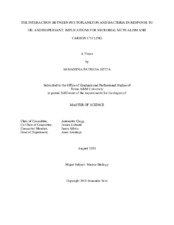| dc.description.abstract | Microbial communities play a vital role at the base of the food web providing and recycling essential nutrients and carbon for larger organisms. Phytoplankton in the ocean are responsible for approximately 50% of global primary production. After phytoplankton leeching, lysis, or death, this fixed carbon can be recycled by bacterial communities. During the 2010 Deep Water Horizon (DwH) oil spill in the Gulf of Mexico, on site researchers and responders recorded unprecedented formations of marine snow. In the presence of oil or oil plus dispersants, microbial communities also produced marine oil snow (MOS); aggregates in which oil has become entrapped. In order to determine key players in phytoplankton–bacterial interactions responding to oil spills, natural microbial communities were collected from two sites in the Gulf of Mexico, an ‘open ocean’ site near the Flower Garden Banks, and a ‘coastal’ site off the coast of Louisiana. Mesocosm tanks (~100 L) were used to examine impact of oil spill both with and without the dispersant on the microbial (prokaryotic and eukaryotic) community composition. The eukaryotic community composition was driven by the type of water mass (open ocean vs. coastal) and treatment, while the prokaryotic community composition was primarily influenced by treatment. Interactions between microbial communities were compared using statistical associations in a co-occurrence network. Key players in the interaction between phytoplankton and bacteria include putative hydrocarbon degraders (mainly Alpha- and Gammaproteobacteria), especially Methylophaga, and Pseudalteromonas. The Methylophaga and Pseudalteromonas interacted with Bacillariophyceae and Dinophyceae based on water mass (open ocean vs. coastal) and treatment. Heterotrophic Paraphysomonas, and mixotrophic Dinophyceae interacted with other phytoplankton and bacteria and appeared to be especially resilient to oil spills. Bacillariophyceae dominated in the coastal experiment, and both Bacillariophyceae and Dinophyceae, which release EPS in response to stressors, were more interconnected in the dispersed oil network analysis. The interaction between microbial organisms is shaped by oil/dispersant and/or EPS production. Competition and resiliency to oil spills was also a key component in the response of Fungi and grazers. By identifying the key players in response to oil spills, further studies can elucidate the microbial response. | en |


